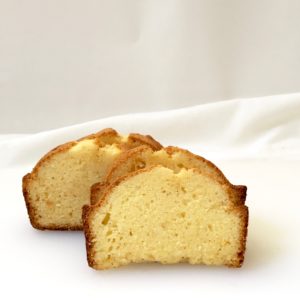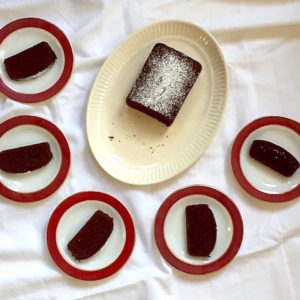Marble Pound Cake
The past week saw your hostess dealing with rodents in kitchen (that screaming you heard? it was me), and a near automobile accident. The other driver–who was at fault–attempted to confront me. (That screaming you heard? It was me.)
This driver, who was backing out of a parking lot without looking, wisely reconsidered.
Then our neighbor, who is a little strange around the edges, decided to touch up his car’s paint job. With spray paint.

(not his car)
Not surprisingly, our home soon filled with toxic fumes. The kind that settle in your throat and choke you.

(how I felt)
I did not scream this time, because this guy is our neighbor and love thy and all that. (Also, choking makes screaming difficult.) Staggering outside, I sweetly asked whether he might consider spray painting the car (?!) in the morning, before the wind kicked up.

Note time photo was taken. Morning. Before the breeze kicks in.
“Oh,” Neighbor sez “is it bothering you? I didn’t realize.”
Did I mention this man is a professional housepainter?
—
As promised last week, the recipe for marble pound cake.

Marble Cake
Adapted from the Perfect Pound Cake recipe in Ruth Reichl’s My Kitchen Year.
Yield: 1 nine inch/23 cm loaf cake
Baking time: about one hour
Instead of writing “see notes” numerous times, please read the notes section before baking. Thank you.
1 cup/2 sticks/8 ounces/227g unsalted butter, at room temperature.
2 cups/450g cake or all-purpose flour
1 teaspoon baking powder
pinch salt (about 1/8th teaspoon)
4 large eggs
1 teaspoon vanilla extract
3 ounces/85 grams unsweetened chocolate
4 ounces /115 grams white chocolate
3/4-1 cup/ 170-227g sugar
All ingredients need to be at room temperature; butter should be removed from the refrigerator at least four hours before baking.
Have two clean spatulas, a large metal spoon, two microwave safe cups, and a large bowl within reach. You need a stand or handheld mixer to bake this cake.
Preheat the oven to 350F/180C
Unwrap the butter and dump it in the stand mixer’s bowl. Use the butter paper to grease a 9inch/two pound/23 cm baking pan (or grease the pan with butter).
Now measure the flour, baking powder, and salt into the large bowl. Blend with a large metal spoon or whisk. Set the floury bowl and unwashed measuring cup aside.
*
Crack the eggs. Set two medium sized bowls or measuring cups in the sink. Crack each egg into first bowl, one at a time, removing any bits of shell with half an eggshell. Transfer the clean egg into the second bowl. Proceed until second bowl has four eggshell-free eggs. (If you are an expert cracker of eggs, feel free to use a single bowl.) Set eggs beside mixer.
Measure vanilla or almond extract into the eggs.
Measure sugar into the cup you used to measure flour.
*
Keeping them separate, break the unsweetened and white chocolates into pieces. Place chocolates in microwave safe cups or containers and melt by giving them ten to twelve second bursts, removing cups from the oven, stirring, and repeating until melted. Set aside.
*
Now start beating your butter. Using the paddle attachment, set mixer on high speed and beat butter for at least five minutes. As Reichl says, you cannot overdo this: the butter should turn white. While it mixes, clean up.
Gradually add the sugar. You may need to stop the mixer to scrape down the bowl and beaters.
Keeping scraping down the mixing bowl if necessary. Once all the sugar is added, tip in the first egg. Allow each egg to blend completely before adding the next. As the third and fourth egg go in, the butter may appear to curdle. That’s okay. Batter will cohere when flour is added.
Reichl recommends adding the flour by hand. I find it easier to add the flour in three batches, blending by giving the mixer a few turns on low speed. Whatever you choose–adding flour by hand, with a large spoon, or using the mixer–be gentle but firm, and don’t overmix. You don’t want to knock out the air.
Add the chocolates: dollop about 1/3 of the batter into the flour bowl. Don’t fret over exact amounts: use a big spoon, and spoon out three spoonfuls. Now add the unsweetened chocolate to this batter. If the chocolate has hardened, give it good stir. Five seconds in the microwave is fine. Use a spatula to scrape it out of the cup. It’s messy. That’s okay. Blend as best you can.
Now add the white chocolate to the batter in the mixing bowl.
Now add some vanilla batter to the loaf pan, smoothing gently, then dollop in some chocolate, then vanilla, finishing with chocolate, gently swirling for a marble or at least twirled effect. By now my kitchen is always a terrible drippy mess; any bakery would fire me. Don’t worry. Is there batter in the pan? Great! Slide it into the oven. Note the time. Pour a drink.
Bake cake about 60 minutes. A tester will come out clean. Place cake pan on rack to cool. You can remove it from the pan after about 20 minutes. Allow to cool completely before eating.
Marble Pound Cake will keep, well-wrapped, up to five days at room temperature. Cake freezes well up to four months.
Notes/Variation:
You can bake this cake with just the white chocolate, which adds subtle depth. Credit for this idea goes to Luisa Weiss and her Marmorkuchen recipe in Classic German Baking. Weiss, in turn, credits her assistant, Maja Welker.
Ruth Reichl specifies using high fat, cultured European butter like Plugra or Echiré. I use Kerrygold most of the time, which is indeed excellent. But plain old American butter is fine, too.
Cake flour is lower in protein than all-purpose flour, creating a lighter crumb. This is important when baking a wedding cake, but either flour is fine here.
As white chocolate is very sweet, I prefer reducing the amount of sugar in the recipe to 3/4 cup. Don’t go below this or the cake’s structure will suffer.





